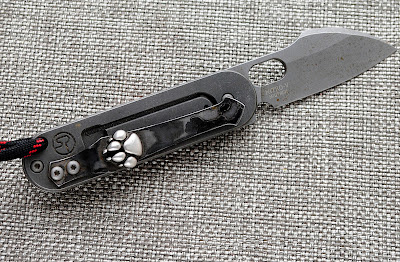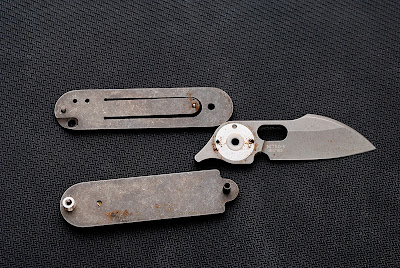I
recently picked up an interesting knife, a Serge Panchenko Skull Bean.
 |
| Serge Panchenko Skull Bean |
I didn't know it at the time; I literally picked it up from the floor near an escalator in a mall. Nobody was around to ask if it was their knife, so it came home with me.
The blade was labeled 'Midtech
Nitro-V,' but stamped on the frame was a stylized S P in a circle. Being made with nitro-V was my first tip that
this was a good knife.
Nitro-V stainless was
first introduced in 2017 and sold by New Jersey Steel Baron. It could be one of the first steels
explicitly made for the knife industry.
It is known for its edge retention, high hardness, and corrosion
resistance (especially in salt environments). It can withstand impacts and stresses without
chipping, a property always valuable for knife steel.
Another question was,
what is the handle material? Once upon a
time, I could run detailed chemical analysis.
But now I just knew it wasn't magnetic.
It didn't look like aluminum, so I suspected titanium.
But who made the knife?
I tried Google
searching and looked through lists of maker's marks, but nothing clicked. I tried a Google image search, which returned
as 'looks like a stamp.' Yeah, that was
helpful.
 |
| The stamp looks a little like E.T. on profile |
Thanks to Facebook, I
got the name Serge Panchenko. Now my
searches revealed it was one of his models called the Skull Bean – Harpoon slip
joint.
I usually don't get
excited about slip joints, but this one was different. The bottom of the knife, where the slip joint
spring is usually located, is open. The tension
spring is side-mounted under the clip with a ball detent that holds the blade
closed or open. A small screw head
mounted near the tang of the blade acts as a travel stop for both the open and
closed positions.
 |
| The tension/spring bar is built into the side wall of the knife. You can see it under the clip. |
Very clever. I don't know why other slip joints don't license
or develop a version of this. It would
undoubtedly make their knives more interesting.
I wanted to clean it,
but not drastically alter the knife's condition. The first step was to cut the paracord weight
off. Then I tackled the Torx
screws. I wasn't sure what I'd
find. Panchenko described his knives as
having a ball-bearing race. I could
visualize tiny bearings scattering everywhere.
The clip came off first. One suggestion I got from Facebook was confirmed. The clip was an aftermarket replacement from Steel Flame.
 |
| A custom Steel Flame clip |
 |
| Hiding under the clip |
Then I removed the butt screw, followed by the pivot screw. I got lucky here—no ball bearings to lose or struggle with. Two very thin circles of white plastic acted as separators and lubrication between the blade and frame. I assumed it was Teflon, which I'd use, but that's a guess on my part. I carefully wiped them off so as not to fold, spindle, or lose them.
 |
| Most of the dirt and or corrosion was on the inside. See the plastic washers? |
 |
| How about now? I wanted to be sure I didn't lose them. The two indents in the blade tang click open or closed. The white area is really a highly polished surface. |
The parts went into to
my ultrasonic for a mild scrubbing.
Ultrasound cleaning uses high-frequency sound waves to create cavitation
bubbles. With some solvents, cavitation
bubbles can reach temperatures hotter than the sun's surface. I once studied aluminum tire molds cleaned by
ultrasonics. Dirty tire molds became
junk very quickly in soapy cleaning solutions.
Ultrasonics work best with hard particles on hard surfaces.
I didn't want that
level of cleaning and used a 50/50 mixture of Clenzoil and WD40. I wanted the protective nature of the
solution to penetrate under any surface corrosion and loosen it up.
A couple of minutes in
the ultrasonic peeled off a little surface grime and staining. The discoloration under the clip needed a
little light-duty persuasion with a Super Eraser. So did the blade. I could have bead blasted the frame and
blade, but I like an honest working patina, so I cleaned it enough to make specks
a little less noticeable.
I reassembled the knife
with a bit of Teflon lube around the washers, and it works fine.
 |
| Cleaned and re-assembled |
It was the lanyard that gave me trouble. The knife weighs about 62 grams, and the lanyard decoration weighs 35 grams. The lanyard hanging out of your pocket is a great way to assist losing it. Perhaps the non-locking, short-blade knife was set up as a flail. Using the knife as a handle, whipping the heavy, raised surface sphere would make an impression in just about anyone.
 |
| I believe the knot is called a king knot. |
I picked out a cord I
had and turned to YouTube to learn how to tie a decorative King knot. My first one was perfect. But that one wasn't on the knife; it was just
practice. The next three were near
misses. Finally, I tied the knot
correctly, and I'm happy with the outcome, even if it does need a little more work.
Did I sharpen it a bit? Sure. I touched up the blade with my Spyderco Sharpmaker. It needed a little touch up and I'm happy with edge.
 |
| Finished. I really like that blade shape and the opening lever is very interesting |
But what's the knife
worth? Don't know.
I emailed Serge Panchenko
with a few questions, but he never answered.
The clip is custom, it is a unique knife, and the handle is titanium,
and I think it is worth…..?
1 comment:
Thanks for sharing this amazing blog. I recently upgraded my workshop with gear from Vevor and was impressed with the quality and service. Before you check out, make sure to search for a Vevor Discount Code—I found one online and saved a nice amount on my order. It’s a quick and practical way to cut costs on essential tools!
Post a Comment